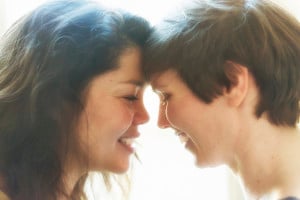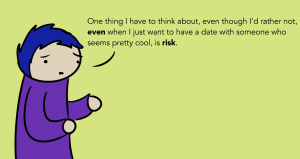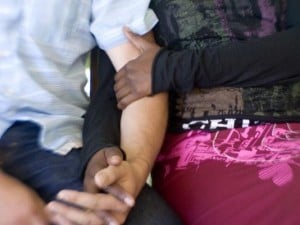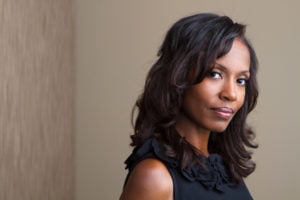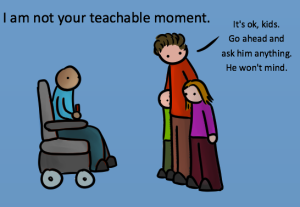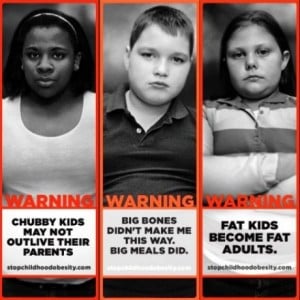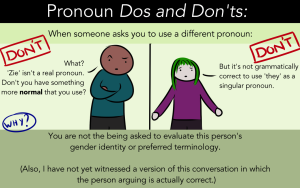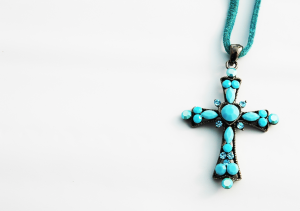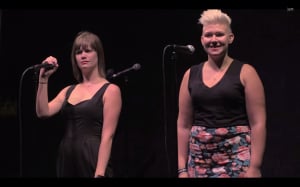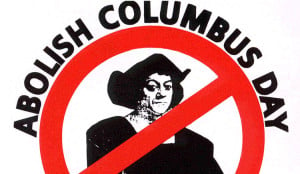Maybe I’m a naïve feminine-presenting queer, but it wasn’t until I began dating my partner who is a masculine-identified and masculine-presenting queer person that I found out from various community members that this type of relationship is a “thing.”
What do I mean by “thing?”
I mean it’s kind of a social expectation that someone who looks the way I do would wind up with someone who identifies and looks like my boo.
More importantly, it’s a privilege within the queer community that garners recognition and acceptance.
Allow me to explain.
Up until this point, my queer partners have been femme-presenting women, which means that when we’re in public space, the assumptions most straight folks make is that we were particularly touchy straight friends. We’re basically invisible and under the radar as queer because of our gender identities and presentation.
Worse, when we would kiss or straight up touch each other, people often think we’re doing it for straight male attention. (Gah, I know.)
So dating someone masculine-presenting is new for me. All of it – the visibility, the assumptions and especially the privileges.
After a few high-key irritating exchanges with various people making erroneous comments about me and my gender identity based on my relationship, I compiled a short list of lessons I’ve learned these past few months.
These are basically some not-to-dos and whys.
This one goes out to all my femme-identified or femme-reading folks (and trust me, yes – all of the exclamation marks are necessary).
1. Stop Assuming I’m Exclusively into Masculine-Presenting Folks Because I’m Femme!
When I began dating my partner, I mentioned them to an acquaintance whose response was super surprising to me.
Knowing nothing of my dating history, she assumed that I exclusively date masculine-identified and -presenting people. In fact, she and some of her friends even took bets on whether I date “butches like her.” Clearly, she bet against me.
I was kind of shocked that a radical butch like herself would pigeonhole me like this, but it was an Obama-esque teachable moment in which I learned that I, as a femme-reading woman, am supposed to be exclusively into masculine folks because of—well— heteronormativity – or in this case, homonormativity.
The textbook definition of heteronormativity is “the institutions, structures of understanding and practical orientations that make heterosexuality seem not only coherent – that is, organized as a sexuality – but also privileged.”
In other words, it’s the way we structurally and socially assign convention and importance to the straight, cis-masculine-looking dude and his presumably straight, cis-feminine girlfriend.
On the other hand, homonormativity, as Everyday Feminism contributor Laura Kacere has graciously helped us to understand it, is, in part, how queer folks ourselves can perpetuate our own-community assumptions – like femmes exclusively date masculine presenting folks.
Homonormativity therefore describes not only “that queer people want to be a part of the dominant, mainstream, heterosexual culture, and the way in which our society rewards those who do so,” but also that there are ways of being that are validated and expected even amongst radical queers.
Probably because I’ve been dating femme women, I was outside of these kinds of homonormative expectations.
What I’ve found is that the persistent nature of homonormativity applies specifically to me as a femme-reading woman to erase the possibility of my dating other women who present like I do.
Expectations are that my queer relationships look a lot like this – even though mine rarely, if ever, do.
Moreover, the notion that I might even embody traits other than what my femme presentation implies are almost never considered.
In other words…
2. I May Read Femme, But Maybe I’m Also a Little Butch
I have a fraught relationship with identifying as femme.
More than anything, I’m perceived as femme, but it’s not an identity that’s an easy fit. It’s also not one I always claim, but is frequently imposed on me by different community members at different times depending on the situation.
For instance, during last year’s NBA finals, I showed up in a tank top with a bucket of fried chicken to a friend’s house to watch the Warriors game, and he said, “God, can you get any more butch?”
This struck me as odd because I can’t count the number of times queer women-identified friends have labeled me femme.
The truth of the matter is, I don’t generally identify as femme. But a consequence of my relationship is that because my partner is transmasculine, people assume I’m femme, not to mention conventionally “feminine.”
As Vanessa Vitiello Urquhart beautifully put it over at Slate, femme identity is often about celebrating an uncompromising feminist femininity.
And while I think that’s dope, I don’t really do that.
I know a lot of badass femmes who are total intellectual, physical, and spiritual forces and deploy a super intentional femme-ness, but that’s not me.
Unfortunately, what I and many folks who read femme or are femme have in common is the assumption that we are the passive, “emotional” partners in our relationships, even though that’s frequently not the reality.
More often than not, I’m pretty reluctant to share my feelings, and I’m pretty damn assertive.
Just because I read femme doesn’t mean I either identify that way or that I have normatively “feminine” personality traits.
And my choice of partner definitely isn’t an indicator of either.
3. You’re Not the Only Queer in the Room
Here in Oakland, it can seem like all queers look a certain way.
At some point, we’ve all had a cool side-shave haircut, wear t-shirts with revolutionary slogans on them, have glasses, and do some sort of social justice work.
A lot of the time, we have a common look – but is that what makes someone queer?
Before this relationship, I’d never had my queerness validated so much by other community members. When my partner and I walk into a room, we look like Bay Area queers who probably know a lot about feminism and do movement work. And we are.
Then again, we could just as easily not be any of those things.
A friend recently told me about their experience with a partner who identifies as genderqueer like they do. In public spaces, they often read like a straight couple and queer friends sometimes say to them, “Bummer, it looks like there aren’t any queers here,” just based on looking around the room.
It makes me wonder, is this how we as a community want to gauge who’s queer – with aesthetics?
As a community that is often committed to defying gender and sexuality stereotypes, isn’t it a little problematic to rely so heavily on visual not to mention other limited social cues? I mean, do we really want it to come down to who in the room is wearing a jean vest?
Which leads me to my next point…
4. I’m Always Queer
A few weeks ago, I was giving someone a ride home, and they said to me, “If you don’t munch carpet, you’re not queer.” I initially laughed because it’s been a while since I heard the phrase “carpet muncher,” but the conversation got me thinking.
What strikes me as problematic, if not painful about this kind of policing of identity is that a fundamental part of my queerness is the desire for all types of people and bodies. I date across the gender spectrum.
Why does being physically intimate with one particular body make me less queer?
My partner will totally hate reading this, but I’ll happily take the heat because I want to validate folks who are queer like me and date cis women, trans folks, gender non-conforming folks, and – yes – cis dudes.
That last partner choice seems to be the most problematic for other queers.
I know countless femme-reading and femme-identified friends who are afraid to “come out” as dating a cis man because they’re afraid to be seen as less radical, less down, less queer.
I even dated a butch woman who, despite having a relationship with me and knowing how I identified, told me she still didn’t believe I was queer because of my presentation and past partners!
The fact of the matter is that no matter who I’m dating, I’m always queer-identified.
Even if my partner isn’t. I remain queer in every relationship.
For me, my queer identity isn’t elastic; it doesn’t shift depending on my partner. What does change with each partner is my level of privilege.
5. That Privilege Thing
While my queerness never changes, I am totally aware that I have cis and straight-passing privilege as a femme-reading woman.
And even though I’m just as queer when I’m with a cis straight guy as I am when I’m with another queer person, the former relationship makes navigating the world a very different experience.
I own all of my privilege of being cis, straight-passing femme woman.
However, what I didn’t anticipate is the level of homonormative privilege I would experience in queer community as the result of being partnered with someone masculine-presenting.
Never before have I walked around my city and been encountered with such celebratory acknowledgement. I’ve noticed that when I’m with my masculine presenting partner we always get the queer head nod, the one that says, “hey I see you and you’re queer too!” in public spaces.
And once, when we were on a date, someone approached us and said, “I love your love,” like we were some sort of HRC marriage equality ad.
It’s something that’s never happened to me when dating another femme-reading women. It’s a social privilege and recognition I didn’t know existed.
If this relationship has taught me anything about homonormativity, it’s this: that shit is real.
Femme-reading queers can be invisible unless we’re with butch or masculine-presenting partners.
Navigating queer social spaces with a partner that everyone reads as queer is a privilege because you’re suddenly considered a visible part of community.
***
I’m not in the business of gatekeeping.
I’m not interested in who is or isn’t butch, femme, or queer. I don’t find that kind of policing productive because it’s done to me all the time.
I am interested in carving space for different versions of queer identity that are just as valid and legitimate as others.
Because at the end of the day, there’s more than one way to be queer – and it’s about a lot more than what you wear, how you act, or what your date looks like.
[do_widget id=’text-101′]
Kim Tran is a doctoral candidate in Ethnic Studies and Gender, Women’s and Sexuality Studies at UC Berkeley. She is a collective member of Third Woman Press: Queer and Feminist Publishing and facilitates workshops on queer cultural competency and uprooting anti-black racism in the Asian American community. Her writings on gender, race, and economics have appeared in The Feminist Wire, Black Girl Dangerous, and Nation of Change. More of her work can be found on her website.
Search our 3000+ articles!
Read our articles about:
Our online racial justice training
Used by hundreds of universities, non-profits, and businesses.
Click to learn more


